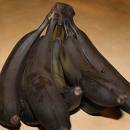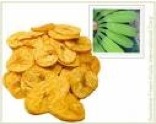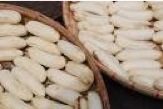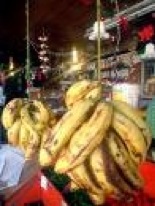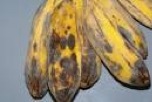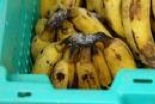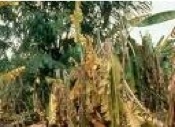
History of the Banana: 1800 to Present


Today, bananas are both a major staple in the global tropical zone as well as an important cash crop and significant fruit varietal available for American and European consumption. They are the fourth most important crop worldwide for developing countries, where they provide an important starch source, especially in Africa and Asia. For instance, in Africa, as much as 400kg of plantain are consumed per year as a main source of calories. Bananas are produced mainly in tropical and sub-tropical areas of Africa, Asia, and America, as well as the Canary Islands and Australia. The fruit is non-seasonal, and thus available year round, where it provides key foodstuffs between seasonal harvests of other staple crops.
The vast majority of bananas grown today are for consumption by the farmers or the local community, with only 15% of the global production of the fruit grown for export. India is the leading producer of bananas worldwide, accounting for 23% of the total banana production, though most of the Indian plantains are for domestic use. Bananas are of significant economic importance elsewhere, such as the French Caribbean and Central America. In the French Caribbean (Guadeloupe and Martinique), banana farming represents a huge industry, where about 260,000 plantains are produced each year. Ecuador, Costa Rica, the Philippine Islands, and Colombia account for two-thirds of the exported banana crops. Of the bananas grown for export, almost all are desert bananas grown for markets in the United States and Europe, of which the “Cavendish” banana varietal is of supreme importance. In general, the United States consumes fruits from Central and South America, whereas consumers in the European Union receive most of their plantains from the Caribbean. Exported bananas are often picked in an unripened state, which makes for much easier transport to their countries of destination as “green” bananas are more resistant to spoilage and bruising than ripened fruits. Upon the end of their journey, the immature fruit are placed in special rooms filled with ethylene gas, which ripens the fruit to maturity.
The banana’s development into a major worldwide trade commodity has its roots in the nineteenth century. Individual merchants shipped plantains from the Caribbean to American and European markets in the early 1800s. The local market proved to be the center of commerce for the early banana trade; bananas were produced on small farms by indigenous persons. Those bananas not immediately consumed by the farmers were sold in local markets to other members of the community. Visiting merchants thus first gained access to bananas through these local marketplaces, and ship small bunches to overseas markets, and the banana’s journey of global production, trade, and consumption had begun. In 1804, plantains reached New York, and sold as novelty fruit to curious consumers. Yet, despite its entrance into the global market, the banana was not to become a major factor in commerce for another few decades.
Technological and shipping limitations affected the banana’s ascendance in world trade. For one, the technique of harvesting unripened bananas had not yet been invented, nor had the technology of refrigeration. Instead, farmers harvested plantains ripe, thus making it susceptible to bruising and spoilage on journeys, especially those of long distance. Navigating roads to the market exposed the banana to jolts and jostlings that could bruise and batter the fruit. Transporting the banana overseas proved to be even more of a challenge, as the weather rendered clippers, and other sailing ships, and by extension their fruit cargo, vulnerable to squalls and storms that could destroy the fragile plantains. Yet, as hostile as the shipping environments were to the banana’s accessibility in foreign markets, other elements were also at play.
Underdeveloped mass markets were perhaps the greatest factor limiting the banana’s ascendancy to a world commodity. Bananas reached Europe and America, but in small numbers and at specific ports. The banana trade in the United States, for instance, was limited to port cities of the Northeast in the early nineteenth century. From 1800 to 1830, red bananas of Cuban origin were sold in the port cities of New York and Boston, but never with any regularity. Thus, in the early 1800s, despite its presence in the overseas marketplaces of the West, the banana never reached a wide saturation point in the diets of Europeans and Americans. Yet, the plantain trade from a local to global commodity was already tenuously in place, with the actual movement of bananas, in however small amounts and in however limited port markets, from South America and the Caribbean into North American and European marketplaces.
By the mid-nineteenth century, the elements that limited the banana’s exposure in the overseas markets of Europe and the United States were in the first stages of decline. The various elements keeping the banana from exploding on the world market were beginning to be worn away by various discrete changes in factors limiting the fruit’s trade. In the 1820s and 1830s, British botanists in the United Kingdom’s overseas colonies became fascinated with the banana plant and fruit. Englishman Charles Telfair, enamored with the bananas he encountered on his journeys around the Indian Ocean and China, began a collection of plantain plants on the island Mauritius. In 1829, he shipped a couple of banana plants to an acquaintance in England, where they eventually passed into the hands of the 7th Duke of Devonshire, William Cavendish, upon his acquaintance’s passing. Cavendish was able to cultivate the plants, and the Cavendish banana was formally recognized as a cultivar in 1836. From England, the cultivar was subsequently diffused back into the tropical zones, including, with the help of such missionaries as John Williams, introductions into previously unknown environments, such as islands of the South Pacific. In 1855, the Cavendish banana spread from Tahiti into Hawaii, Australia, and Papua New Guinea.
Simultaneous with the spread of the Cavendish varietal across the Indian and Pacific Oceans, small-scale banana exports from Cuba continued to make their way into the North Atlantic ports of the United States. The imports into the U.S. continued to gradually increase over the next few decades, especially with the end of the American Civil War, but remained an exotic fruit in American cuisine well into the 1870s. Within the next forty years, the overseas banana market would explode. In 1871, banana exports into the United States were valued at around $250,000. By the first year of the twentieth century, the banana trade had exponentially ballooned to $6,400,000. Ten years later, it had effectively doubled again. Various factors in American culture, society, and economies helped to drive the demand for the banana.
One factor driving banana demand in the late 1800s and early 1900s in America was its price. Though details are sketchy, the banana may have been lower in price at the marketplace than the ever-popular apple, and this competitive advantage, coupled with its significant caloric content, much greater than most other fruits, made it an attractive, cost-effective food for Americans of every social class. Indeed, a 1913 proposal to reinstate an import duty on bananas that had been earlier abolished met with fierce resistance from consumers. The collective consumer action was a testament to the bananas growing popularity, and officials shelved the proposed duty in the face of such widespread consumer protest. Thus, the relative cheapness of the banana, coupled with other factors, helped to drive the demand for the starchy fruit.
Another element in the banana’s rising demand lay in the overall status of fruits in the national economy. By the end of the nineteenth century, larger and larger quantities of fruits, from the old standbys of strawberries, peaches, melons, and of course apples, to the newer bananas and citrus fruits, appeared in American marketplaces. In turn, fruits began to be seen as an increasingly important to a healthy diet. Bananas flourished in the fruit-positive culture, and were cited in various cookbooks, pamphlets, and popular literature as a healthy food. For instance, ripe bananas became associated with gastrointestinal health, and various experts noted their importance to human digestion.
The banana’s popularity also sprang from its unique physique. Concern for public health lay at the heart of American society in the late eighteenth and early nineteenth century, so much so that public policy reflected a new awareness of pathogens with the rise of the germ theory. In an era when growing awareness of disease, especially bacteria and viruses, and disease transmission, dominated public health discourse, bananas offered the perfect food. The banana peel, with its ensured sterility, offered consumers a food that was both germ-free as well as nutritious.
Thus, factors leading to a rise in the demand for bananas during the end of the nineteenth and beginning of the twentieth century included its safety from contamination, along with its relatively low price, its relatively high caloric content, and its overall status as a healthy food. For these reasons, bananas also enjoyed a rise in Europe, though not at the same scale as the American plantain mania. Regardless of their relative scale, the foreign demand for banana consumption in led to a dramatic increase in banana production in tropical countries of the New World.
By the mid-1880s, at the same time United States officials removed import duties from the fruit, banana production expanded from Cuba and other islands in the Caribbean into Central America, including Mexico, Honduras, Costa Rica, Panama, and into such South American countries as Colombia. By the 1890s, bananas were flooding into the American trade hubs in New York, Louisiana, Maryland, Pennsylvania, and Alabama. Small-scale and independent shipping of the fruit gradually consolidated into huge shipping and production conglomerates, culminating in the formation of the United Fruit Company (UFC) in 1899.
The increasing demand for bananas, and the lucrative banana trade, as exemplified by the UFC, had massive effects on the production of plantains on Caribbean, Central American, and South American farms. Small-scale cultivation gradually gave way to more intense production to maximize yield and minimize loss. Banana traders increasingly influenced the development of harvesting practices that both limited varietals to breeds deemed desirable for European and American markets as well as those timed to produce during the peak seasons of banana consumption, March through June. Gradually, one breed of bananas began to stand out as a particularly profitable fruit, the Gros Michel or “Big Mike.”
The Big Mike banana offered a major advantage to most other plantains: its thick, resilient peel. The resilience of Big Mike offered the sweet fruit of the desert banana preferred by Westerners with better armor. The Gros Michel was the perfect candidate for plantation monocultures, and rapidly supplanted most other bananas grown for American and European consumption.
As consumption, production, and trade grew, so did a demand for better shipping technologies that could meet the requirements of the foreign markets. That is, banana shippers now needed new ways to shield the notoriously fragile fruit. Even with the greater resistance to bruising offered by the Big Mike’s thick peel, banana traders still needed extra protection for the banana’s journey from production to consumption. Thus, schooners of the old guard were nearly extinct by the 1880s, as ships powered by steam took over the banana shipments. Steamships, with their steady power supplies, offered guarantees against the weather systems that could waylay the vessels that relied on the sail. Steamers, also because of their inexorable energy, could also hold and carry larger quantities of fruit than the clipper. Fruit shipments, therefore, were both larger than ever and much less likely to be delayed en route, allowing for more consumable, that is, unspoiled, product to reach the marketplace. Additional boons to the shipping industry arrived with the burgeoning refrigeration industry, allowing a substantial reduction in fruit spoilage. By the 1920s, the export of desert bananas was a lucrative, well established business for the United Fruit Company and other fruit corporations. A major upheaval in the industry, however, sparked by an unprecedented environmental disaster, loomed.
The switch from polyculture to monoculture in banana plantations had important consequences. Perhaps the most obvious was a massive upswing in banana production. As the desert banana dominated the overseas banana trade, plantations turned to intensively managed crops of one kind of plantain, the Gros Michel, for their harvests. At the end of the nineteenth century, the Big Mike was the dominant varietal, indeed oftentimes the only varietal, grown on plantations throughout South and Central America. The result was an unprecedented growth in banana exports during the early twentieth century. By 1929, exports from the banana producing areas of tropical America reached a then world-record of 29 million bunches, up dramatically from the 8.4 million of 1912. But such intensive production came with a massive cost: susceptibility to pathogens.
The intense monoculture had swathed the landscapes of Latin America in Gros Michel farms. Moreover, because banana cultivation requires vegetative reproduction, given the fruits seedless, and therefore asexual, properties, the acres of Gros Michel banana crops were all genetically identical. From 1899 onward, a plantain pathogen known as Fusarium oxysporum, colloquially known as “Panama Disease” or “fusarium wilt,” began spreading through banana plantations worldwide. Panama disease, caused by a soil fungus, inevitably led to the death of its host, and the Gros Michel varietal proved particularly vulnerable to the fungus. By the 1930s, Panama disease had diffused to nearly all of the banana farms of the American tropics, and by the 1950s had annihilated the Gros Michel commercially. The fruit conglomerates had no choice but to abandon the varietal in favor of newer forms, and by 1958, the plantations turned to the Cavendish varietal, a smaller, less flavorful version of the Big Mike, but with a greater resistance to Panama Disease.
Today, the Cavendish banana remains the dominant banana varietal exported. However, it, too is in danger of commercial extinction. A strain of fusarium wilt, known as “Tropical Race Four,” is diffusing from Southeast Asia across the tropical band, spread by both anthropogenic and natural means. The Cavendish is vulnerable to this strain of Panama Disease, and its commercial extinction, like its predecessor, seems likely. Yet, the danger of Panama Disease, and its ilk, is not solely the burden of the desert banana, and thus the relatively small (15% worldwide) portion of bananas grown worldwide.
Banana diseases at epidemic levels threaten not only the monoculture plantations, but also the smaller, diverse banana crops propagated by small-scale farmers throughout the world. If a disease manages to evolve past a resistant breed’s natural defenses, it may be able to “jump” the barrier from non-resistant types to affect even resistant varieties of the fruit. Thus, an epidemic disease may be commercially devastating, but it is potentially of even greater danger to the millions of bananas grown for subsistence around the world. If epidemic disease jumps readily from banana-type to banana-type, humans around the tropical world face potential starvation on a massive scale. A worldwide, pan-plantain epidemic may be inconvenient for Americans and Europeans, but fatal for millions in Africa, India, and Southeast Asia. The banana’s future, and those of its cultivators, remains unknown.
Bibliography:
Banana; accessed on 10 June 2008.
Connor, Steve. “Lack of Sex Life Threatens Banana Crops.” The Independent, 27 July
2001.
Heslop-Harrison, J.H. and Trude Schwarzacher. “Domestication, Genomics, and the
Future for Banana,” Annals of Botany 100, no. 5 (2007): 1073-1084.
Mirsky, Steve. “Attack on the Clones.” Scientific American vol. 298, no. 4 (March
2008).
“Musa (genus).” Musa (genus) - Wikipedia, the Free Encyclopedia. http://
en.wikipedia.org/wiki/Musa_%28genus%29; accessed on 10 June 2008.
Soluri, John. Banana Cultures: Agriculture, Consumption, and Environmental Change
in Honduras and the United States. Austin: University of Texas Press, 2005.
Soluri, John. “Banana Cultures: Linking the Production and Consumption of Export
Bananas, 1800-1980.” In Banana Wars: Power Production and History in the
Americas, ed. Steve Strffler and Mark Morberg, 48-79. Durham and London:
Duke University Press, 2003.
Wiley, James. The Banana: Empires, Trade Wars, and Globalization. Lincoln:
University of Nebraska Press, 2008.

The History of the Banana: Is the End Nigh?

